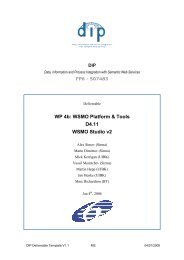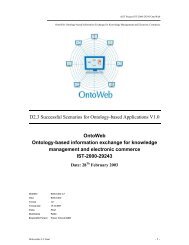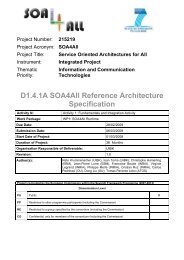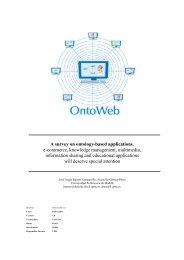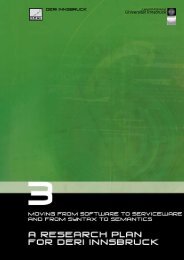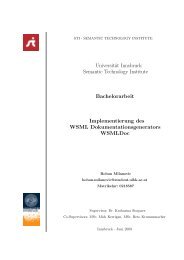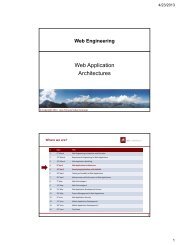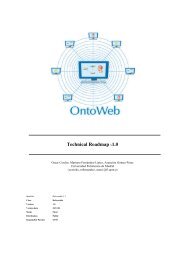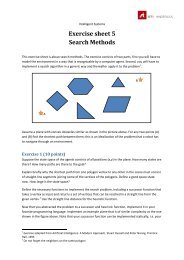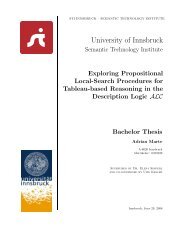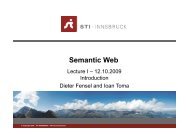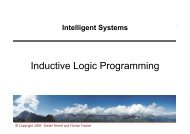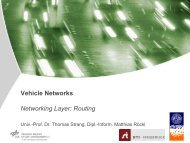D7 â Dynamic Ontology Management System (Design) - STI Innsbruck
D7 â Dynamic Ontology Management System (Design) - STI Innsbruck
D7 â Dynamic Ontology Management System (Design) - STI Innsbruck
Create successful ePaper yourself
Turn your PDF publications into a flip-book with our unique Google optimized e-Paper software.
INFORMATION SOCIETIES<br />
TECHNOLOGY<br />
(IST)<br />
PROGRAMME<br />
IST-2001-33174<br />
A knowledge management platform with intelligence<br />
and insight capabilities for technology intensive<br />
industries<br />
<strong>D7</strong> – <strong>Dynamic</strong> <strong>Ontology</strong> <strong>Management</strong> <strong>System</strong> (Design)<br />
WorkPackage:<br />
WP3 - <strong>Dynamic</strong> <strong>Ontology</strong> <strong>Management</strong> <strong>System</strong><br />
Version: Final 1.0<br />
Author(s):<br />
Editor: A. Kokossis, P. Sujoy<br />
Contributors: R. Banares-Alcantara, A. Moreno, A. Aldea, D. Isern, J.<br />
Bocio, D. Fensel, Y. Ding, A. Gouzinis, K, Drakas, N Routzouni, C.<br />
Syrmas, D. Synodinos, R. Brown<br />
Company(s):<br />
UniS,<br />
URV, VUA, ATC<br />
Submission Date: 1/10/2002<br />
Confidentiality:<br />
Consortium & EC<br />
Deliverable Type:<br />
External<br />
© Copyright by the h-TechSight Consortium.<br />
The h-TechSight Consortium consists of:<br />
University of Surrey (UniS) Project Coordinator UK<br />
University Rovira i Virgili (URV) Partner Spain<br />
Vrije Universiteit Amsterdam (VUA) Partner Netherlands<br />
SemanticEdge Partner Germany<br />
Athens Technology Center SA (ATC) Partner Greece<br />
IchemE Partner UK<br />
BAYER AG Partner Germany<br />
P.N. GEROLYMATOS SA (PNG) Partner Greece<br />
Jet Oil Partner Greece<br />
Institut Français du Pétrole (IFP) Partner France
D07_01_DOMS_F01<br />
SUMMARY<br />
One of the objectives of the h-TechSight project is the development of tools that help to build and<br />
dynamically maintain knowledge maps related to a specific knowledge-intensive domain. A first<br />
design of a dynamic ontology management system to be used for this purpose is proposed in this<br />
document.<br />
In Section 1 the rationale concerning the development of a <strong>Dynamic</strong> <strong>Ontology</strong> <strong>Management</strong> system is<br />
described. In Section 2, we present the basic capabilities of a dynamic ontology management system;<br />
the system should be able to build, manage and dynamically update ontologies. Sections 3 and 4 are<br />
focused on the two main components of the system: an ontology personalisation interface (built on top<br />
of OntoEdit and Sesame) and a multi-agent information search engine. This multi-agent search engine<br />
is composed of a collection of intelligent information agents which search the web to find and rate<br />
concepts related to the ontology provided by the user.<br />
In summary, the aim of this first version of this document is to present an initial design for a dynamic<br />
ontology management system that will be able to semi-automatically manage the dynamic evolution<br />
of ontologies in a complex, real-world domain. A second version of the documents will be released<br />
when the dynamic ontology management system is fully designed. A prototype of this system will be<br />
presented at month 18 of the project.<br />
IST-2001-33174 © h-TechSight Consortium October 2002 Page 2 of 27
D07_01_DOMS_F01<br />
Table of Contents<br />
SUMMARY........................................................................................................................................................... 2<br />
1. INTRODUCTION ....................................................................................................................................... 5<br />
1.1 RATIONALE ............................................................................................................................................ 5<br />
1.2 ACRONYMS AND ABBREVIATIONS ......................................................................................................... 5<br />
1.3 LIST OF RELATED DOCUMENTS.............................................................................................................. 6<br />
2. A DYNAMIC ONTOLOGY MANAGEMENT SYSTEM....................................................................... 7<br />
2.1 REQUIREMENTS...................................................................................................................................... 7<br />
2.2 ARCHITECTURE OF THE DYNAMIC ONTOLOGY MANAGEMENT SYSTEM ................................................... 8<br />
3. ONTOLOGY PERSONALISATION INTERFACE.............................................................................. 10<br />
3.1 ONTOEDIT ........................................................................................................................................... 10<br />
3.2 SESAME................................................................................................................................................ 11<br />
3.2.1 Overview......................................................................................................................................... 11<br />
3.2.2 The Repository Abstraction Layer .................................................................................................. 11<br />
3.2.3 Repository....................................................................................................................................... 11<br />
3.2.4 The RDF Administration Module ...................................................................................................11<br />
3.2.5 The RQL Query Module ................................................................................................................. 11<br />
3.2.6 The RDF Export Module ................................................................................................................ 11<br />
3.3 THE REPOSITORY CONSTRUCTION: GINY ............................................................................................. 11<br />
3.4 JENA .................................................................................................................................................... 11<br />
3.5 XBASE................................................................................................................................................. 11<br />
4. A PROTOTYPE MULTI-AGENT INFORMATION SEARCH SYSTEM ......................................... 11<br />
4.1 INTRODUCTION .................................................................................................................................... 11<br />
4.2 MULTI-AGENT SYSTEM ARCHITECTURE............................................................................................... 11<br />
4.3 CASE STUDY: SEARCH FOR BIOSENSOR COMPANIES.............................................................................. 11<br />
4.4 FUTURE WORK .................................................................................................................................... 11<br />
REFERENCES ................................................................................................................................................... 11<br />
APPENDIX A: WEB SITE MATCHES ................................................................................................................... 11<br />
IST-2001-33174 © h-TechSight Consortium October 2002 Page 3 of 27
D07_01_DOMS_F01<br />
Index of Figures<br />
Figure 1: <strong>Dynamic</strong> <strong>Ontology</strong> <strong>Management</strong> <strong>System</strong>................................................................................8<br />
Figure 2: OntoEdit interface. ................................................................................................................10<br />
Figure 3: Options available in OntoEdit after connecting to Sesame ...................................................11<br />
Figure 4: Sesame architecture ([Broekstra et al., 2002]).......................................................................11<br />
Figure 5: Stacking of RALs to add functionality ([Broekstra et al., 2002]) .........................................11<br />
Figure 6: The RQL query module ([Broekstra et al., 2002]) ................................................................11<br />
Figure 7: Evaluating an RQL query using Sesame ...............................................................................11<br />
Figure 8: GINY’s Framework Model ...................................................................................................11<br />
Figure 9: Xbase <strong>System</strong> Schema...........................................................................................................11<br />
Figure 10: Multi-Agent Search <strong>System</strong> Architecture............................................................................11<br />
Figure 11: Ontologies handled by the Coordinator Agent....................................................................11<br />
Figure 12: Product class and its properties ..........................................................................................11<br />
Figure 13: Documents found for each class in the "Company" ontology............................................11<br />
IST-2001-33174 © h-TechSight Consortium October 2002 Page 4 of 27
D07_01_DOMS_F01<br />
1. INTRODUCTION<br />
1.1 RATIONALE<br />
Since in a complex technical domain not every user may be interested in all aspects of the domain, the<br />
ontologies developed in h-TechSight need to be organised according to different user roles. Such<br />
personalised ontologies must be flexibly configurable in order to cope with a complex and<br />
dynamically changing environment. For example, it must be possible to define personal organisation<br />
schemes that allow classifying ontologies with respect to a personal view (i.e., topics related to the<br />
personal competencies). To provide this ability, we need to develop a tool that will support this type<br />
of functionality. In order to ease the use of the tool, it should be able to automatically classify the<br />
stored knowledge, at least according to some standard categories.<br />
In a chemical engineering example, for instance, there is a “Product_Specifications” model with<br />
standard categories “Product_chemistry”, “Production_technology”, “Materials_suppliers”,<br />
“Product_markets”, “Environmental_burden” (or “Global_warming_effects”), and<br />
“Product_maturity”. Thus a user could specify a “Product_Specifications” ontology from a<br />
“Production_Technology” perspective. This should give the user only parts of the ontology, which<br />
are relevant to production technology.<br />
Besides providing the ability for a user to personally configure an ontology, it would be extremely<br />
important and beneficial to incorporate self-correcting capabilities to the ontology. This will provide<br />
the ability to grasp the dynamic profile of a knowledge domain, (e.g. trends and expertise in demand,<br />
new dynamics and markets, declining fields and professions), which may translate to impressive gains<br />
in increasing business intelligence.<br />
In view of the above, the h-TechSight project aims to provide a <strong>Dynamic</strong> <strong>Ontology</strong> <strong>Management</strong><br />
system that will incorporate these capabilities.<br />
1.2 ACRONYMS AND ABBREVIATIONS<br />
DAML DARPA Agent Markup Language.<br />
DB DataBase.<br />
DBMS DataBase <strong>Management</strong> <strong>System</strong><br />
FIPA Foundation for Intelligent Physical Agents.<br />
GUI Graphical User Interface<br />
HTML HyperText Markup Language.<br />
JADE Java Agent Development Environment.<br />
MAS Multi-Agent <strong>System</strong>.<br />
OIL <strong>Ontology</strong> Interchange Layer.<br />
OODBMS Object Oriented DataBase <strong>Management</strong> <strong>System</strong><br />
RAL Repository Abstraction Layer<br />
RDB Relational Data Base<br />
RDF Resource Description Framework.<br />
RDFS Resource Description Framework Schema.<br />
RQL Object Oriented Query Language<br />
SQL Structured Query Language.<br />
IST-2001-33174 © h-TechSight Consortium October 2002 Page 5 of 27
D07_01_DOMS_F01<br />
SOAP<br />
WWW<br />
XML<br />
XOL<br />
Simple Object Access Protocol<br />
World Wide Web.<br />
eXtensible Markup Language.<br />
XML <strong>Ontology</strong> Exchange Language<br />
1.3 LIST OF RELATED DOCUMENTS<br />
1. IST-2001-33174: H-TechSight Annex 1, Description of Work<br />
2. D2 – State of the Art KM technologies and practices<br />
IST-2001-33174 © h-TechSight Consortium October 2002 Page 6 of 27
D07_01_DOMS_F01<br />
2. A DYNAMIC ONTOLOGY MANAGEMENT SYSTEM<br />
2.1 REQUIREMENTS<br />
The <strong>Dynamic</strong> ontology management system should be able to satisfy the following requirements:<br />
• Building dynamically interrelating ontologies: Provide the ability to replace conventional<br />
ontology schemas with advanced ontologies that can analyse and present highly relevant<br />
information. In particular, to be able to validate and sustain components from the ontology<br />
using the available information from the web (or any other source). Conceptually similar<br />
documents will be clustered and grouped into one or more categories and the information can<br />
become available by crawling text sources on particular subjects, with a purpose to generate<br />
statistical information such as term frequency and proximity.<br />
• Automatically updating ontologies: The ontologies should be automatically updated as<br />
knowledge assets are added to and removed from repositories. The ability to analyse<br />
documents and assign them to an appropriate category is one way to overcome one of the<br />
largest obstacles to effective knowledge management: the timely and accurate knowledge<br />
classification.<br />
• To periodically and dynamically assess the relative position of the ontology and its<br />
components: Provide the means to monitor and dynamically update knowledge structure<br />
(knowledge maps). Be able to periodically and dynamically analyse changes in the knowledge<br />
domain, point new fields and terms, and automatically report findings to the user.<br />
Technically speaking the defined requirements can be translated in the following:<br />
1. Design and implementation of an interface to personalise ontologies and customise the knowledge<br />
map of the technology areas that the user needs to explore. This should be able to allow:<br />
• Importing and reusing existing ontologies.<br />
• <strong>Ontology</strong> pruning for removing irrelevant parts of an imported ontology<br />
• <strong>Ontology</strong> refinement to complete the ontology at a fine granularity<br />
• <strong>Ontology</strong> consistency management to ensure consistent evolution of the ontology.<br />
2. Design and implementation of Search Agents that are capable to discover new concepts and<br />
support the automatic update of the ontology terms.<br />
Both the framework for defining ontologies and the ontologies themselves need to be defined using<br />
extensions of XML such as XOL (XML <strong>Ontology</strong> Exchange Language) and of RDF (Resource<br />
Description Framework) such as RDFS. The utilisation of standard representation frameworks will<br />
ensure interoperability of the <strong>Ontology</strong> Personalisation Interface and the Multi-Agent Information<br />
Search <strong>System</strong>. The design of these sub-systems is described in the following sections.<br />
IST-2001-33174 © h-TechSight Consortium October 2002 Page 7 of 27
D07_01_DOMS_F01<br />
2.2 ARCHITECTURE OF THE DYNAMIC ONTOLOGY MANAGEMENT SYSTEM<br />
The design of the proposed system is depicted in Figure 1. The system consists of two differentiated<br />
but collaborative parts:<br />
• The intelligent search engine (shaded top block) and<br />
• The knowledge repository and ontology personalisation interface (shaded bottom right block).<br />
Figure 1: <strong>Dynamic</strong> <strong>Ontology</strong> <strong>Management</strong> <strong>System</strong><br />
The expert communicates with the proposed system by generating a domain ontology or by asking the<br />
personalisation interface system to provide him/her with an ontology customised to his/her own<br />
requirements. Once a domain ontology is created, the user agent (A user ) requires information related to<br />
this ontology to the knowledge repository or to the search engine. The agent decides whether the<br />
information stored in the repository is good enough for the user expectations or the search engine is<br />
required to update this information with new knowledge extracted from the web.<br />
These two main subsystems are described in more detail in the following sections of this document,<br />
but we want to first show the exchange of information between them with an example. Let's assume<br />
that a user who is not an expert requires information about cells applied in biosensors. The user could<br />
import an already built biotechnology domain ontology (domain ontologies are stored in the RDFs<br />
database, repository, and are supported by SESAME). After importing a domain ontology, the user<br />
could perform two actions: he/she can consult the information stored in the repository (the repository<br />
stores information which was previously discovered from the web or manually introduced);<br />
alternatively, the user can invoke the intelligent search engine and obtain new data from the web. The<br />
first option is the simplest and it only requires one select operation from the database. The second<br />
option requires the use of search agents that seeks information about cells applied in biosensors. The<br />
agents return a sorted collection of links which will be analysed by GINY [Riaño and Gramajo, 1998]<br />
in order to compose the instances of the domain ontology. Following the example, let's suppose that<br />
the http://www.fst.rdg.ac.uk/courses/fs560/topic3/topic3.htm link was found by a search agent, GINY<br />
IST-2001-33174 © h-TechSight Consortium October 2002 Page 8 of 27
D07_01_DOMS_F01<br />
analyses the link and discovers that there are microbial cells, amplifiers, antibodies, etc. with<br />
different attribute values. All the discovered information will be sent to the user for further<br />
consultation and analysis. The information will also be sent to the repository to get stored.<br />
The ontology personalisation interface and the repository constructor tool, GINY, are introduced in<br />
the next section. The intelligent search engine is described in Section 4.<br />
IST-2001-33174 © h-TechSight Consortium October 2002 Page 9 of 27
D07_01_DOMS_F01<br />
3. ONTOLOGY PERSONALISATION INTERFACE<br />
The advent of the semantic web ([Berners-Lee, 1999]) has made it imperative to develop ontologies<br />
as the mechanism that enables machines to communicate and garner knowledge. In light of this<br />
context, we propose a design that will enable us to seamlessly interact the front-end ontology editing<br />
tool (OntoEdit) with a repository (MySQL, http://www.mysql.com). This is facilitated by the use of a<br />
middleware tool (Sesame).<br />
3.1 ONTOEDIT<br />
OntoEdit is a graphical based <strong>Ontology</strong> Engineering tool (its GUI is shown in Figure 2) that supports<br />
the development and maintenance of ontologies and is available either in the stand-alone or clientserver<br />
format [Staab et al., 2000][Sure et al., 2002]. The internal ontology model on which it is based<br />
allows the domain to be developed through the use of classes, relations, axioms, facets and attributes.<br />
The interoperability of the tool is facilitated by the development of plugins which permits it to interact<br />
with other tools like Ontobroker and Sesame. There are plugins that allow the user to import and<br />
export ontologies, portal assembly kits, integrated inferencing and ontomapping ([Sure et al., 2002]).<br />
The connection between OntoEdit and Sesame is shown in Figure 3.<br />
The tool permits the usage of DAML+OIL and RDFS. There are two versions available (a free edition<br />
with some limitations and the professional edition with all the features). The Free version allows the<br />
usage of only 50 instances whereas the Professional version, in addition to the facilities available for<br />
the Free version, has an extended functionality that allows consistency checking of the ontology and<br />
an ontology server for the administration and storage of ontologies.<br />
Figure 2: OntoEdit interface.<br />
IST-2001-33174 © h-TechSight Consortium October 2002 Page 10 of 27
D07_01_DOMS_F01<br />
Figure 3: Options available in OntoEdit after connecting to Sesame<br />
3.2 SESAME<br />
Sesame, developed by AIdministrator (see http://www.aidministrator.nl), is an architecture that allows<br />
persistent storage and effective querying of metadata in RDF and RDFS. This tool is implemented<br />
using Java and it can be download for free. Sesame can easily be within other complex systems, such<br />
as the one being developed in the h-TechSight project.<br />
3.2.1 Overview<br />
Sesame has been designed and implemented to be independent of any storage devices. As such, it can<br />
be implemented on top of RDBMS, OODBMS, triple stores without having to change the query<br />
engine.<br />
Sesame interacts with the DBMS through the Repository Abstraction Layer (RAL) interface. RAL<br />
communicates with 3 functional modules viz. the RDF administration module, the RQL query module<br />
and the RDF export module. These components then communicate with their clients either by HTTP<br />
or SOAP by their respective protocol handlers as shown in Figure 4.<br />
IST-2001-33174 © h-TechSight Consortium October 2002 Page 11 of 27
D07_01_DOMS_F01<br />
Figure 4: Sesame architecture ([Broekstra et al., 2002])<br />
3.2.2 The Repository Abstraction Layer<br />
Repository Abstraction Layer (RAL) is a stable interface that offers RDF-specific methods to the<br />
clients and translates these calls to API methods for specific DBMS. As such, it allows the user to<br />
insert, delete and retrieve metadata from the repository. Currently (for version Sesame 0.6), only 2<br />
DBMS are supported by RAL: MySQL (http://www.mysql.com) and PostgreSQL (http://<br />
www.postgresql.org).<br />
RAL has been designed to transfer data in streams thereby facilitating the return of result sets as soon<br />
as they are available without having to store large amounts of data in memory ([Broekstra et al.,<br />
2002]). This gives the flexibility to access large volumes of data without the need for memory<br />
configuration or expensive hardware. As such, the repository is used for the persistent storage of the<br />
data. However, without caching the data in memory it impedes performance and minimizes one of the<br />
essential functionalities of RDBMS.<br />
In order to ameliorate this problem, layers of RAL can be stacked on top of another, allowing the<br />
functional modules to communicate with only the top layer of the abstraction layer. The RAL at the<br />
top then forwards these call to the layer beneath and the process goes on till the result is returned, as<br />
shown in Figure 5.<br />
IST-2001-33174 © h-TechSight Consortium October 2002 Page 12 of 27
D07_01_DOMS_F01<br />
Figure 5: Stacking of RALs to add functionality ([Broekstra et al., 2002])<br />
It can therefore, be implemented to cache schema-data which is accessed frequently. However, due to<br />
the transitive nature of subClassOf and subPropertyOf in RDFS, it is difficult to query from a DBMS.<br />
Hence, by placing the schema-caching RAL, thereby allowing it to handle only schema related calls,<br />
on top of other RALs which can then forward other calls to the underlying RAL.<br />
3.2.3 Repository<br />
The different types of repositories that Sesame allows are as follows:<br />
• DBs: Although RAL has been designed to permit the interaction with different DBMS,<br />
Sesame (as of version 0.6) only communicates with MySQL and PostgreSQL databases.<br />
• Files: Flat files can be used as storage devices which when combined with a schema-caching<br />
RAL can be effective in dealing with small amounts of data<br />
• Repositories: Sesame can access data across any RDF network services and hence permits the<br />
usage of remote repositories. It would be interesting to see whether we can make usage of<br />
added database functionalities like replication.<br />
3.2.4 The RDF Administration Module<br />
This module currently performs 2 functions, namely the insertion of RDF data and schema<br />
incrementally and deletion of the data from the repository. It is, however, not possible to update RDF<br />
data and schema. The options available are (1) uploading data, (2) removing statements and (3)<br />
clearing the entire database. Therefore, the solution for 'updating' an ontology is to extract all data<br />
(e.g. using OntoEdit), modify it locally, clear the entire database, and upload the modified data (4).<br />
This module retrieves information from the RDF(S) source, parses it using the SiRPAC RDF parser<br />
[Barstow, 2000]. The parser then delivers the information to the module according to the RDF<br />
IST-2001-33174 © h-TechSight Consortium October 2002 Page 13 of 27
D07_01_DOMS_F01<br />
statement (Subject(S), Predicate(P), Object(O)) and checks the consistency of each statement with the<br />
information already present in the repository and draws information, if necessary, as:<br />
• if P equals type, then it infers that O must be a class<br />
• if P equals subClassOf, then it infers that both S and O are classes<br />
• if P equals subPropertyOf, then it infers that both S and O are properties<br />
• if P equals domain or range, then it infers that S is a property and O is a class<br />
3.2.5 The RQL Query Module<br />
Sesame uses a variant of RQL ([Broekstra et al., 2002], [Alexaki et al., 2000]) as compared to the<br />
declarative language originally developed within the European IST project C-Web. This version of<br />
RQL supports both optional and multiple domain and range restrictions.<br />
The module parses the query, builds a query tree model and is then fed to the query optimiser. The<br />
optimiser then transforms the query model into an efficient, equivalent model. This is illustrated in<br />
Figure 6.<br />
Figure 6: The RQL query module ([Broekstra et al., 2002])<br />
The query model is subsequently evaluated in streams, thereby facilitating the retrieval of data<br />
without caching the data. This model translates RQL queries into a set of calls to the RAL, thereby<br />
allowing the evaluation of the query to be done in the query engine itself unlike the RDF Suite where<br />
the query is performed in the engine of the DBMS (see Figure 7).<br />
3.2.6 The RDF Export Module<br />
This module supports the usage of both the schema and non-schema part of the data. It exports the<br />
contents of a repository formatted in XML-serialised RDF.<br />
<strong>Ontology</strong> editors like OntoEdit can then use either the schema or non-schema or both from the<br />
extracted information.<br />
IST-2001-33174 © h-TechSight Consortium October 2002 Page 14 of 27
D07_01_DOMS_F01<br />
Figure 7: Evaluating an RQL query using Sesame<br />
3.3 THE REPOSITORY CONSTRUCTION: GINY<br />
GINY [Riaño and Gramajo, 1998] is a framework that allows the automatic structuring of<br />
information. An unsupervised Clustering process is employed to obtain the structure that should be<br />
used to store the information about a specific domain which is represented by a domain ontology [Jain<br />
and Dubes, 1988].<br />
As shown in Figure 8, GINY is organised as a front-end where users (human or agents) can make<br />
queries and obtain responses from a centralised database.<br />
GINY receives the domain ontology and communicates with the multi-agent search engine to obtain<br />
the unstructured retrieved information related to the domain. This information is used by the Data<br />
Structure Extractor to obtain a conceptual ER model to store this information. This model can produce<br />
both a DDL script that defines a relational database or a RDF description of a knowledge-base.<br />
GINY’ s framework is depicted in Figure 8. GINY requires an ontology that provides the structure of<br />
the required information (classes and attributes which will get a value when an instance of this class is<br />
discovered) and links to web pages that contain information about the classes. Every link is<br />
considered as an instance of a class and thus the values for its attributes can be obtained from the<br />
analysis of such web pages. The web pages will be analysed by a Natural Language Analyser module<br />
which builds a data table with the extracted responses. Finally, that table is given to the Data Structure<br />
Extractor Module that generates the data and knowledge structures and fills them with the web<br />
information. These structures will be then stored in the repository where the user can access them<br />
through SQL queries.<br />
IST-2001-33174 © h-TechSight Consortium October 2002 Page 15 of 27
D07_01_DOMS_F01<br />
USER<br />
Query<br />
Definition<br />
Search<br />
<strong>Ontology</strong><br />
Knowledge<br />
FRONT END<br />
Search<br />
Application<br />
Query<br />
Result<br />
Search<br />
Engine<br />
Data<br />
Table<br />
Inductive<br />
Learnig<br />
Structure<br />
DB<br />
Data<br />
Question/Answer<br />
INTERNET<br />
Figure 8: GINY’s Framework Model<br />
3.4 JENA<br />
JENA (http://www.hpl.hp.com/semweb/index.html) is a toolkit for developing semantic web<br />
applications. This toolkit is a Java API that manipulates RDF models. Its features include:<br />
• statement centric methods to manipulate a RDF model as a set of RDF triples<br />
• resource centric methods to manipulate a RDF model as a set of resources with properties<br />
• cascade method calls for more convenient programming<br />
• built in support for RDF containers - bag, alt and seq<br />
• enhanced resources - the application can extend the behaviour of resources<br />
• integrated parsers (ARP and David Megginson' s RDFFilter)<br />
This latest release of the Jena toolkit integrates a number of new components, some of which are also<br />
available separately:<br />
• ARP parser compliant with latest working group recommendations<br />
• integrated query language (RDQL)<br />
• support for storing DAML ontologies in a model<br />
• persistent storage module based on Berkeley DB<br />
• support for persistent Jena models in relational databases<br />
• open architecture supporting other storage implementations<br />
IST-2001-33174 © h-TechSight Consortium October 2002 Page 16 of 27
3.5 XBASE<br />
D07_01_DOMS_F01<br />
XBASE is a system that allows the translation of information between XML and a Relational Data<br />
Base (RDB), it implements query mechanisms as a subset of the SQL language over a set of XML<br />
data files and RDB. The access to these two kinds of data sources is transparent to the user who<br />
receives an integrated answer of the data.. The translation process is shown in Figure 9.<br />
Figure 9: Xbase <strong>System</strong> Schema<br />
IST-2001-33174 © h-TechSight Consortium October 2002 Page 17 of 27
D07_01_DOMS_F01<br />
4. A PROTOTYPE MULTI-AGENT INFORMATION SEARCH SYSTEM<br />
4.1 INTRODUCTION<br />
The system to be described helps the user in the search for information on a specific domain. Its<br />
objective is to avoid as much as possible the two main problems of keyword based web search,<br />
namely that some of the retrieved documents are irrelevant, and that some of the relevant documents<br />
may not be retrieved. These problems derive from the nature of keyword based search and from the<br />
lack of structure in the searched documents.<br />
It has been identified previously that ontologies can improve the accuracy of web searches because<br />
the search program can look for web pages that refer to a precise concept (in context and with detailed<br />
information) [Kokossis&Bañares-Alcantara, 2003]. The prototype system involves several<br />
ontologies:<br />
• a domain ontology (an input from the user), providing the initial information about the domain of<br />
search,<br />
• a set of query ontologies (intermediates), resulting from partitioning the domain ontology into<br />
smaller (more specific) ontologies,<br />
• a set of response ontologies (intermediates), consisting of the information found during the search<br />
(one response ontology is created per each query ontology), and<br />
• an information ontology (an output from the system), which is the result of merging the response<br />
ontologies.<br />
All of them are implemented in RDF (Resource Description Framework, http://www.w3.org/RDF)<br />
which is becoming the de facto standard for the representation of ontologies [Fensel, 2001]. The<br />
domain ontologies were generated with two well known graphical ontology editors, OntoEdit<br />
(http://www.ontoprise.de/ontoedit.htm) and Protégé-2000 (http://protege.stanford.edu/index.html).<br />
4.2 MULTI-AGENT SYSTEM ARCHITECTURE<br />
Figure 10 depicts the Multi-Agent <strong>System</strong> architecture.<br />
Figure 10: Multi-Agent Search <strong>System</strong> Architecture<br />
IST-2001-33174 © h-TechSight Consortium October 2002 Page 18 of 27
D07_01_DOMS_F01<br />
The agents that perform the search for information and its further classification are:<br />
• The Internet Agents.<br />
Given a concept with some associated properties, i.e. a query ontology, this type of agent searches<br />
the web with the help of one or more internet search engines and returns the web pages related to<br />
this concept in the form of a response ontology. The retrieved web pages are sorted according to a<br />
weight function. The system can deploy as many internet agents as requested.<br />
• The Coordinator Agent.<br />
This agent receives as an input the domain ontology created by the user, and is responsible for<br />
partitioning it into several query ontologies which are sent to the Internet Agents. The Coordinator<br />
Agent is in charge of generating the knowledge base that stores all the responses given by the<br />
Internet Agents. The Coordinator Agent must therefore merge and classify all the response<br />
ontologies into the information ontology. The response ontology generation process is not an easy<br />
task. The information is distributed and sometimes duplicated, and the agent must be able to place<br />
it in the appropriate location within the structure created by the user (see Figure 11).<br />
• The Broker and User Interface Agents.<br />
The Broker Agent acts as a facilitator, indicating to the Coordination Agent, for example, the state<br />
of each of the Internet Agents so that the idle ones can be assigned a task. The User Interface<br />
Agent allows the user to specify a query and to configure the initial ontology, in other words<br />
control the target and focus of the search.<br />
Figure 11: Ontologies handled by the Coordinator Agent<br />
IST-2001-33174 © h-TechSight Consortium October 2002 Page 19 of 27
D07_01_DOMS_F01<br />
The first prototype of this system has been implemented in JADE (Java Agent Development<br />
Environment [Bellifine et al., 1999]), which is a Multi-Agent platform composed by a collection of<br />
Java libraries and that follows the protocol specifications of FIPA (Foundation for Intelligent Physical<br />
Agents (FIPA), www.fipa.org) [Fipa, 2002]. For the case study the Internet Agents are connected to<br />
Google, the search engine (www.google.com), although the system is open to other search engines.<br />
4.3 CASE STUDY: SEARCH FOR BIOSENSOR COMPANIES<br />
The Multi-Agent search prototype was initially tested with a biosensor domain ontology. This<br />
ontology consists of 71 classes with more that 80 properties encapsulated within the classes. The<br />
"Company" class and its subclasses are depicted in the left-hand side of the OntoEdit window shown<br />
in Figure 12. The "Product" class is highlighted and shows all of its properties in the right-hand side<br />
of the window. For this specific class the user decided to include 7 properties or attributes which are<br />
related to this concept, and they are added to the inherited properties from the parent classes of<br />
"Product" (the inherited properties are shown with a grey shade).<br />
Figure 12: Product class and its properties<br />
If the concept to be searched were "Biosensor", the Coordinator Agent would split the domain<br />
ontology into 71 query ontologies. In this case study we have analysed a subset of this ontology: the<br />
"Company" class together with all its subclasses as a result the system works with 9 query ontologies.<br />
In our first prototype, every agent analyses all the links associated with the first 10 results retrieved<br />
from the Google search engine, this amount is configurable. The names of the class and its parent<br />
classes are supplied as keywords to the search engine. Several searches were done with different<br />
numbers of Internet agents and different deadlines. Figure 13 shows the average number of pages<br />
(documents) found which are related to each of the 9 query ontologies using 2 and 5 agents with<br />
different deadlines (0.5, 2.5 and 5.0 minutes). We can see that the system behaves similarly when<br />
operating with deadlines of 2.5 and 5.0 minutes, and that an increase in the number of Internet agents<br />
improves the search. Bear in mind that the agents in the case study must perform searches for several<br />
ontologies as there are less agents than query ontologies.<br />
IST-2001-33174 © h-TechSight Consortium October 2002 Page 20 of 27
D07_01_DOMS_F01<br />
70<br />
60<br />
50<br />
40<br />
30<br />
20<br />
10<br />
0<br />
2 agents 0.5 mins<br />
2 agents 2.5 mins<br />
2 agents 5mins.<br />
5 agents 0.5 mins<br />
5 agents 2.5 mins<br />
5 agents 5mins.<br />
Company<br />
Research<br />
Manufacturer<br />
Technology<br />
Product<br />
Environment_device<br />
Veterinary_device<br />
Industry_device<br />
Figure 13: Documents found for each class in the "Company" ontology<br />
At present the Internet agents analyse every web page and calculate a relevance weight according to<br />
the number of properties of the concepts that can be matched on the document text, and to their<br />
position in the document, i.e. whether they are in the title, headings, plain text, etc.<br />
Once all the pages are processed, they are sorted and sent to the Coordinator Agent. As of the time of<br />
writing this document, the Internet agents generate the response ontologies but the Coordinator Agent<br />
does not yet perform the merge procedure to create the information ontology as planned in the final<br />
architecture, see Figure 10.<br />
To validate the results, we have manually visited the web pages related to the "Environment_device"<br />
class (see Appendix A), and found that the more relevant web pages were indeed those with larger<br />
assigned weights. However, the Internet agents also retrieved irrelevant web pages, these pages were<br />
at the bottom of the relevance list though. As it stands, the user must decide on a “cut value” for the<br />
weights below which results are most likely irrelevant. This value cannot be generalised to other<br />
searches, thus a true solution rather than a patch requires that the web page analyser within the<br />
Internet agents be refined to eliminate as many irrelevant pages as possible.<br />
From the results of the case study we can conclude that the prototype system finds relevant<br />
information (although we cannot prove that it finds all of it!) and successfully prioritises it.<br />
IST-2001-33174 © h-TechSight Consortium October 2002 Page 21 of 27
4.4 FUTURE WORK<br />
D07_01_DOMS_F01<br />
The work has concentrated on the implementation of the Internet agent and this report describes the<br />
preliminary results obtained with our first prototype. The system is not fully implemented yet and<br />
requires further work. We are currently modifying the Internet agents to:<br />
• Improve their weight function calculation.<br />
• At the moment the weight given to each web page is calculated by looking at which<br />
properties are found in the page, the number of such properties, and their position on the<br />
document. We want to improve this function by adding techniques used by other approaches<br />
[Glover, 2002].<br />
• Improve the response ontology.<br />
• In this first prototype the response ontologies consist of a sorted list of web pages. The<br />
response ontologies can be enhanced by providing values for each property found in every<br />
web page.<br />
Once the Internet agents are fully implemented, the Coordinator Agent must be completed to generate<br />
the information ontology that merges and organises all the response ontologies, see Figure 11. This<br />
process is not an easy task, as the retrieved information may be duplicated. As different Internet<br />
agents may find and analyse related web pages, the Coordinator agent should use its knowledge of the<br />
hierarchical relation between the ontology classes and decide if the information is redundant (and thus<br />
remove the repeated information) or not (and keep the two related but complementing pieces of<br />
information). The resulting information ontology will enhance the domain ontology by adding<br />
knowledge extracted from the web pages by the MAS information search system.<br />
The discovery of new concepts will be the next stage of the project. All the web pages can be<br />
processed to discover new concepts that were omitted or unknown to the user. This concepts consist<br />
of new classes, or properties of classes that are found in the retrieved pages but that the user did not<br />
include in the domain ontology. Web mining tools can be used to build ontologies from HTML<br />
documents. The resulting ontology can be compared with the domain ontology (the one created by<br />
the user) to detect new classes or properties. Applicable techniques are employed to generate<br />
databases with information retrieved from internet [Gramajo and Riaño, 2002].<br />
IST-2001-33174 © h-TechSight Consortium October 2002 Page 22 of 27
D07_01_DOMS_F01<br />
REFERENCES<br />
[Alexaki et al., 2000] Alexaki, S., Christophides, V., Karvounarakis, G., Plexousakis, D., and Tolle,<br />
K. (2000). The RDFSuite: Managing Voluminous RDF Description Bases. Technical report,<br />
Institute of Computer Science, FORTH, Heraklion, Greece. See<br />
http://www.ics.forth.gr/proj/isst/RDF/RSSDB/rdfsuite.pdf.<br />
[Barstow, 2000] Barstow, A. and Melnik,S (2000). SirPAC: Simple RDF Parser and Compiler.<br />
http://www.w3.org/RDF/Implementations/SiRPAC<br />
[Bellifine et. al., 1999] Bellifine, F., Poggi, A., Rimassa, G. (1999). JADE. A FIPA-compliant Agent<br />
Framework. In Proceedings of Practical Application of Intelligent Agents and Multi-Agent<br />
Technology (PAAM'99), pp.97-108. London, UK, April 1999.<br />
[Berners-Lee, 1999] Berners-Lee,T. (1999). Weaving the Web, Orion Business Books.<br />
[Broekstra and Kampman, 2001] Broekstra, J. and Kampman, A. (2001). Query Language<br />
Definition.On-To-Knowldege (IST-1999-10132) Deliverable 9, Aidministrator Nederland<br />
b.v. See http://www.ontoknowledge.org<br />
[Broekstra et al., 2002] Broekstra, J., Kampman, A. and van Harmelen, F. (2002). Sesame: An<br />
Architecture for Storing and Querying RDF Data Schema Information, In Proceedings of the<br />
First Internation Semantic Web Conference, pp 54--68, Springer Verlag, Lecture Notes in<br />
Computer Science, 2342.<br />
[Fensel, 2001] Fensel, D. (2001). Ontologies: A Silver Bullet for Knowledge <strong>Management</strong> and<br />
Electronic Commerce. Heidelberg, Germany.<br />
[Fipa, 2002] Foundation for Intelligent and Physical Agents (2002). FIPA Abstract Architecture<br />
Specification. Spec. number XC00001J, Geneva, Switzerland, Foundation for Intelligent and<br />
Physical Agents (FIPA). See http://www.fipa.org.<br />
[Glover, 2002] Glover, E. J. (2002). Using Web Structures for Classifying and Describing Web Pages.<br />
In Proceedings of WWW2002, Honolulu, Hawaii, USA 7-11 May 2002.<br />
[Gramajo and Riaño, 2002] Gramajo, J. and D. Riaño. (2002). Meta-data and ER Model Automatic<br />
Generation from Unstructured Information Resources. 5th Joint Conference on Knowledge<br />
Based Software Engineering, Marivor, Slovenia.<br />
[Jain and Dubes, 1988] A.K.. Jain and R.C. Dubes C. (1988). Algorithms for Clustering Data.<br />
Prentice-Hall Inc., 1988<br />
[Kokossis and Bañares-Alcantara, 2003] Kokossis, A. and R. Bañares-Alcantara. (2003). <strong>Dynamic</strong><br />
Information <strong>Management</strong> for Web-enabled Environments in the Chemical Process Industries.<br />
Accepted for FOCAPO 2003, Coral Springs FL. USA (2003).<br />
[Staab et al., 2000] Staab. S., Angele, J., Decker, S., Erdmann, M., Hotho, A., Maedche, A., Schnurr,<br />
H.P., Studer, R., Sure, Y., (2000). Semantic Community Web portals. In WWW9-<br />
Proceedings of the 9 th International World Wide Web Conference, Amsterdam, The<br />
Netherlands, May 15-19, 2000. Elsevier.<br />
[Sure et al., 2002] Sure, Y., Staab, S., Angele, J. (2002) OntoEdit: Guiding <strong>Ontology</strong> Development<br />
by Methodology and Inferencing. In: Proceedings of the International Conference on<br />
Ontologies, Databases and Applications of SEmantics ODBASE 2002, October 28 -<br />
November 1, 2002, University of California, Irvine, USA, Springer, LNCS.<br />
[Riaño and Gramajo 1998] D. Riaño and J. Gramajo. (1998). Automatic extraction of data structure",<br />
Universitat Rovira i Virgili, URV, Tarragona, EIM-RR-00-004, 2000, 1998.<br />
IST-2001-33174 © h-TechSight Consortium October 2002 Page 23 of 27
D07_01_DOMS_F01<br />
APPENDIX A: WEB SITE MATCHES<br />
Environment_device subClassOf: Product<br />
matches: 14<br />
THE LARGEST SINGLE AREA OF APPLICATION FOR THE ENVIRONMENT<br />
http://www.ibeweb.org/IBE2/news/news1.1/biotech.htm<br />
Title: Biosensor Technology<br />
Images: 3<br />
Ratio: 1<br />
This is a web of the University of Georgia about biosensor technology. Some topics are:<br />
What is a biosensor?<br />
Biological recognition elements<br />
Transduction technology<br />
Biosensor applications<br />
THE DEVICE<br />
http://www.ioffe.rssi.ru/RT/IWRFRI2000/c8.html<br />
Title: Use a carbon materials as biosensor controls<br />
Images: 3<br />
Ratio: 1<br />
Russian web about physical, chemical and biological sensors. This web talks about a device that represents measuring<br />
systems of electrical activity of microbiological test in liquid environment.<br />
ALPHA WEB SMARTS - GLOSSARY - AUSTRALIA'S EXPERT WEB<br />
http://ats.business.gov.au/aws/NSW_391/<br />
Title: ATS: EIDN Pty Ltd -- Luciferase-Based Biosensor: Contaminant Detection -- Energy, Environment, Waste<br />
<strong>Management</strong> - Australian Technology Showcase<br />
Images: 5<br />
Ratio: 1<br />
Australian web about contaminant detection. It states that:<br />
Detection of environmental and biological contaminants has become much easier with the development of a new Luciferasebased<br />
biosensor by the Technology Brokering Division of EIDN Pty Ltd.<br />
TRANSDUCER - A DEVICE<br />
http://www.rpi.edu/dept/chem-eng/Biotech-Environ/BIOSEN/basicsensor.html<br />
Title:<br />
IST-2001-33174 © h-TechSight Consortium October 2002 Page 24 of 27
D07_01_DOMS_F01<br />
Images: 0<br />
Ratio: 1<br />
An Introductory Tutorial on Biosensor Technology. This web talks about issues related to biosensors such as:<br />
Use for biosensors<br />
Molecular recognition<br />
Signal transduction<br />
What are the advantages of biosensors over other measurement schemes?<br />
A BIOSENSOR CAN BE DEFINED AS A COMPACT ANALYTICAL DEVICE<br />
http://www.nbbnet.gov.my/research%20project/exe%20summary/zam.htm<br />
Title: Untitled Document<br />
Images: 2<br />
Ratio: 1<br />
Malaysian web about Development of Biosensor Technology For Detecting Specific Contaminants in Environment and<br />
Agriculture. Issues:<br />
Objective of the project<br />
Status of the research<br />
Methodology and strategies of the research<br />
ALPHA WEB SMARTS - THE WEB RANKING COMPANY<br />
http://www.alphawebsmarts.net/pages/glossary.html<br />
Title: Alpha Web Smarts - Glossary - Australia's Expert Web Ranking Company<br />
Images: 261<br />
Ratio: 1<br />
This is another link of the Australian page found before. The web page presents a glossary about computer science.<br />
HUMAN RIGHTS AND ENVIRONMENT RESOURCES<br />
http://shr.aaas.org/hrenv/glossary.php?g_id=5268<br />
Title: Human Rights and Environment Resources<br />
Images: 18<br />
Ratio: 1<br />
A web page of the Science and Human Rights Program. There is a definition of biosensor.<br />
http://www.netl.doe.gov/publications/proceedings/99/99apprvr/ar4-2.pdf<br />
Title:<br />
Images: 0<br />
Ratio: 1<br />
IST-2001-33174 © h-TechSight Consortium October 2002 Page 25 of 27
D07_01_DOMS_F01<br />
Document of the National Energy Technology Laboratory of the United States of America.<br />
http://www.ua.es/cenemes/coop_tec/ofertas/doc/TO-BIOSENSOR.doc<br />
Title:<br />
Images: 0<br />
Ratio: 1<br />
Document from a Spanish web page, titled: Technology offer: Real time monitoring of BOD (Biological Oxygen Demand) in<br />
effluents<br />
The Spanish company BIOSENSORES has developed a very innovative biosensor for measuring the BOD (Biological<br />
Demand of Oxygen) in water.<br />
ALPHA WEB SMARTS - THE WEB RANKING COMPANY<br />
http://www.alphawebsmarts.net/pages/quotation.html<br />
Title: Alpha Web Smarts - Quotation Form - Australia's Expert Web Ranking Company<br />
Images: 55<br />
Ratio: 1<br />
Another link of the Australian page found before, with a quotation form.<br />
http://www.ibeweb.org/index.htm<br />
Title: Institute of Biological Engineering<br />
Images: 13<br />
Ratio: 1<br />
A web page from the University of Georgia, about the 2003 annual meeting of the Institute of Biological Engineering.<br />
ONE PRACTICAL APPLICATION<br />
http://www.worldandi.com/public/1987/february/ns2.cfm<br />
Title: Biosensors - The World & I Magazine<br />
Images: 34<br />
Ratio: 1<br />
Article about Biosensors from The World & I On-Line<br />
New direct analysis devices made by linking biological and electrical components may soon replace time-consuming,<br />
laboratory methods for detecting small quantities of specific substances.<br />
EMAIL US<br />
http://www.cs.virginia.edu/tricorder/description/<br />
Title: Biosensor Toolkit<br />
Images: 0<br />
IST-2001-33174 © h-TechSight Consortium October 2002 Page 26 of 27
D07_01_DOMS_F01<br />
Ratio: 1<br />
Web page of the University of Virginia about a Biosensor toolkit. Some issues described in this web page:<br />
Molecular Reception.<br />
Biomaterial Science.<br />
Biocomputing.<br />
WEB<br />
http://www.sydney-south-apartment.com.au/table3.html<br />
Title: The Waldorf Apartment Hotel - Table No. 3<br />
Images: 13<br />
Ratio: 0,51<br />
This is an incorrebct retrieval, because it is from an apartment hotel in Sidney. A possible reason for the inclusion of this<br />
web page could be that this page has a link to the previous Australian web page. The system found the word “price” which is<br />
an attribute of the class “Environment_device” and assigns an erroneous ratio.<br />
IST-2001-33174 © h-TechSight Consortium October 2002 Page 27 of 27



